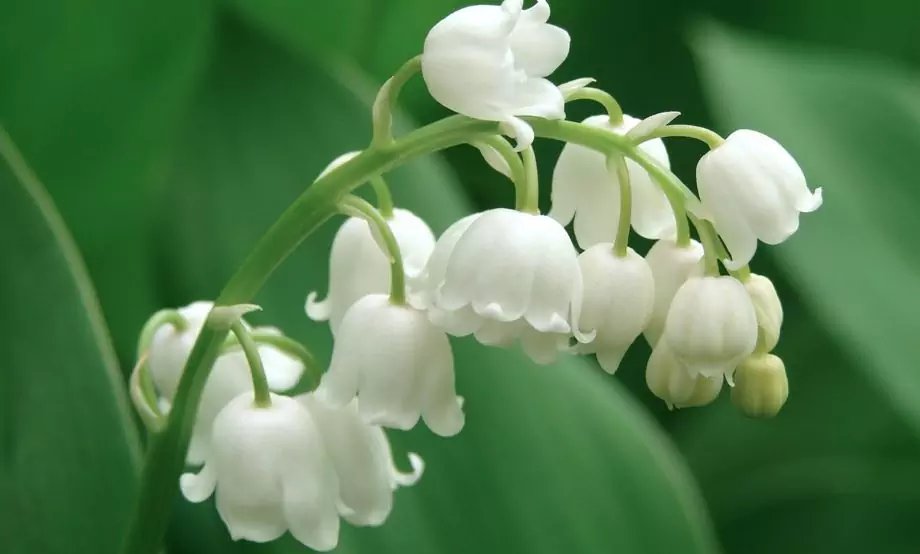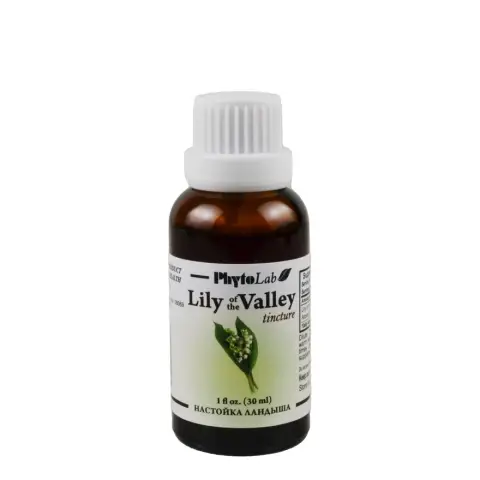- Author Rachel Wainwright [email protected].
- Public 2023-12-15 07:39.
- Last modified 2025-11-02 20:14.
Lily of the valley poisoning
May lily of the valley is a small perennial herb, popular for its beautiful delicate flowers, which can be found along river channels, in clearings, in forests and pine forests, as well as in garden plots. It has medicinal properties, but at the same time it can cause serious poisoning.

Source: depositphotos.com
How does lily of the valley poisoning happen?
Lily of the valley poisoning is usually observed either in children who unknowingly eat the berries of this plant, or in people who are treated with tincture of lily of the valley, neglecting the dosage, or resorting to alternative therapy methods and using homemade lily of the valley preparations.
May lily of the valley is poisonous not only fresh but also dried. Flowers and berries are the most toxic. Poisoning occurs due to the content of a poisonous substance in the plant - konvallatoxin, which belongs to the group of cardiac glycosides and can have a toxic effect on the myocardium (heart muscle), kidneys, nervous system and other organs.
The cardiotonic effect of convallatoxin is associated with its ability to change the ion balance in myocardial cells, increasing the concentration of Na + in myofibrils and decreasing the concentration of K +. As a result, the content of Ca 2+ ions increases, contributing to the formation of actomyosin (contractile protein), which leads to increased systole (cardiac output). Strengthening the systole, in turn, increases the stroke volume, which leads to a greater flow of blood from the left ventricle to the aorta, an increase in blood pressure, irritation of baroreceptors and pressoreceptors, reflex excitation of the vagus nerve center and a slowdown in the heart rate.
In case of poisoning with lily of the valley, the conduction of nerve impulses along the conducting system of the heart is disrupted, which causes an extension of the interval between contractions of the atria and ventricles. Large doses of konvallatoxin can increase the automatism of the heart, cause the formation of heterotropic foci of arrhythmia.
In addition, konvallatoxin has a sedative effect and has a diuretic effect.
Symptoms
The clinical picture of acute lily of the valley poisoning is characterized by:
- severe nausea, followed by indomitable vomiting;
- stomach ache;
- severe general weakness;
- pallor of the skin;
- drowsiness;
- increased blood pressure;
- bradycardia (decreased heart rate);
- arrhythmia.
In case of severe acute poisoning, the initially high blood pressure decreases, disturbances of consciousness, hallucinations occur, and the pulse rate catastrophically decreases - against this background, cardiac arrest may occur.
With long-term treatment with lily of the valley tincture, chronic intoxication of the body can develop, the complications of which are:
- fast weight loss, up to cachexia;
- decompensated heart failure;
- gynecomastia;
- neuralgia;
- xanthopsia (visual impairment in which all surrounding objects appear yellowish);
- various types of disorders of consciousness.

Source: depositphotos.com
First aid for lily of the valley poisoning
When the first signs of lily of the valley poisoning appear, you must first call an ambulance, and then, without wasting a minute, start providing the patient with first aid.
The victim must take activated charcoal at the rate of 1 tablet for every 10 kilograms of body weight. Before taking the tablets, they are crushed into powder and mixed with a little water.
Also, when poisoning with lily of the valley, a saline laxative (for example, Magnesium sulfate) is shown, the reception of which allows you to quickly cleanse the intestines of poisons, thereby reducing the severity of poisoning.
In this case, you should not wash the stomach, since vomiting provokes an increase in parasympathetic tone and increases the severity of atrioventricular block.
When is medical attention required?
In case of lily of the valley poisoning, it is important to seek medical attention as soon as possible. Even if the symptoms of poisoning are not severe, you should not rely on the fact that the malaise will go away on its own.
Treatment of patients is carried out, depending on the severity of their condition, either in the department of toxicology, or in the intensive care unit.
Correction of electrolyte disorders is carried out by intravenous administration of saline solutions.
Therapy of atrioventricular blockade includes the appointment of drugs such as Isoprenaline, Atropine. If drug treatment does not lead to the restoration of the correct heart rhythm, the issue of electrocardiostimulation is decided.
If the patient develops ventricular tachycardia, then Lidocaine, Magnesium sulfate, Phenytoin are administered to stop it.
Extracorporeal detoxification methods (hemosorption, hemodialysis, plasmapheresis), as well as forced diuresis in the treatment of lily of the valley poisoning are ineffective.
Possible consequences
Lily of the valley poisoning is especially dangerous for young children and patients with heart disease, since their myocardial sensitivity to the toxic effects of convallatoxin is increased, and even a small dose can be fatal. Lily of the valley is also dangerous for the elderly, as well as those suffering from kidney diseases with impaired concentration.
Prevention
Prevention of lily of the valley poisoning should be based on active sanitary and educational work.
Parents should explain to their children that they cannot taste any plants and their parts without the knowledge of adults. When you are with your child in nature, you cannot leave him unattended.
It should be borne in mind that lily of the valley poisoning can happen even if you drink water from the vase in which the bouquet stood. Therefore, bouquets of lilies of the valley should be placed at home in places inaccessible to children.
With heart disease, you need to seek help only from official cardiologists. You can not follow the advice of poorly educated healers and "healers" who recommend homemade tincture of May lily of the valley.
If a doctor has prescribed a tincture of lily of the valley, it should be purchased at a pharmacy and, taking it, carefully observe the prescribed dosage and duration of the course.

Elena Minkina Doctor anesthesiologist-resuscitator About the author
Education: graduated from the Tashkent State Medical Institute, specializing in general medicine in 1991. Repeatedly passed refresher courses.
Work experience: anesthesiologist-resuscitator of the city maternity complex, resuscitator of the hemodialysis department.
The information is generalized and provided for informational purposes only. At the first sign of illness, see your doctor. Self-medication is hazardous to health!






